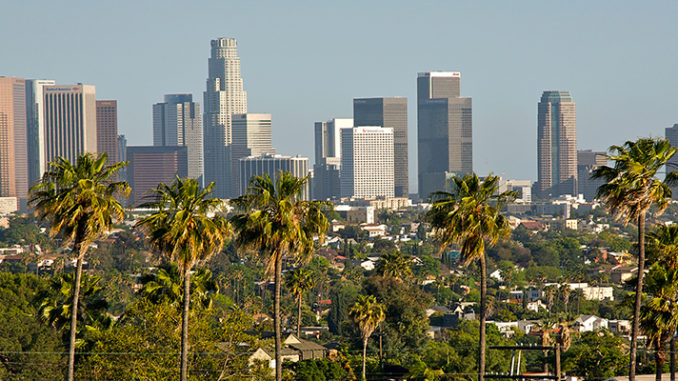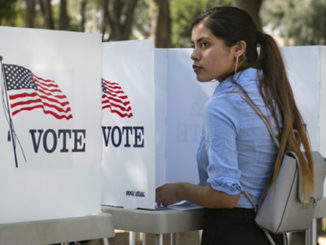
by Michael Grunwald
It’s undoubtedly a blue-state bastion. But far from being a socialist hellhole, the Golden State is thriving after years of malaise.
President Donald Trump loves bashing California—its “ridiculous” sanctuary cities, its “gross mismanagement” of its forests, even the “disgusting” streets of San Francisco. He also enjoys slagging California liberals, like House Intelligence Committee Chair “Liddle” Adam Schiff, House Financial Services Committee Chair “Low IQ” Maxine Waters, and House Speaker Nancy Pelosi, who “has behaved so irrationally & gone so far to the left that she has now officially become a Radical Democrat.” On Wednesday, after Democratic Governor Gavin Newsom decided to scale back the state’s troubled high-speed rail project, the president gleefully mocked it as a green fiasco: “Send the Federal Government back the Billions of Dollars WASTED!”
Now that progressive Democrats are pushing for a California-style Green New Deal to fight climate change, and progressive California Senator Kamala Harris has become a front-runner for the Democratic nomination to challenge Trump, the president’s allies have begun framing 2020 as a last stand against the hippie-lefty Californication of America. Turning Point USA founder Charlie Kirk has warned that “Democrats want California to be the blueprint for America,” while Dan Patrick, the Republican lieutenant governor of Texas, has suggested that Trump’s reelection slogan should be: “I’m not going to let the Democrats turn America into California.”
California has earned its reputation as the politically correct capital of Blue America, a heavily urban majority-minority coastal state where it’s legal to smoke pot but illegal for retailers to provide plastic bags or cops to ask suspects their immigration status. Taxes are high, the first year of community college is free and driver’s licenses have a third option for residents who don’t identify as male or female. But while California has plenty of problems, from worsening wildfires to overpriced housing to that troubled bullet-train project that became the latest target of presidential mockery, there’s one serious hitch in the GOP plan to make California a symbol of Democratic dysfunction and socialistic stagnation: It’s basically thriving.
“California is doing awesome,” says Congressman Ted Lieu, an immigrant from Taiwan who co-chairs the policy and communications committee for the House Democratic Caucus. “It’s a beautiful, welcoming, environmentally friendly place that proves government can work. Who wants to run against that?”
California is now the world’s fifth-largest economy, up from eighth a decade ago. If it’s a socialist hellhole, it’s a socialist hellhole that somehow nurtured Apple, Google, Facebook, Tesla, Uber, Netflix, Oracle and Intel, not to mention old-economy stalwarts like Chevron, Disney, Wells Fargo and the Hollywood film industry. California firms still attract more venture capital than the rest of the country combined, while its farms produce more fruits, nuts and wine than the rest of the country combined. During the Great Recession, when the state was mired in a budget crisis so brutal its bond rating approached junk and it gave IOUs to government workers, mainstream media outlets were proclaiming the death of the California dream. But after a decade of steady growth that has consistently outpaced the nation’s, plus a significant tax hike on the wealthy, California is in much sounder fiscal shape; while federal deficits are soaring again, the state has erased its red ink and even stashed $13 billion in a rainy day fund.
Of course, every state is in better economic shape than it was during the Great Recession, but California has enjoyed its renaissance while pursuing policies Republicans associate with economic ruin. It has an $11-an-hour minimum wage, scheduled to rise to $15 by 2023. Its unusually aggressive implementation of Obamacare since 2013 has reduced its uninsured rate from 17 percent to just 7 percent. Its ambitious clean energy and climate policies in many ways inspired the Green New Deal; the state is committed to generating 50 percent of its electricity from renewable sources by 2030 and 100 percent by 2045, and its stringent fuel-efficiency standards help explain why it’s home to half the nation’s electric vehicles.
In general, California is flourishing while pursuing the exact opposite of the policies Trump is pursuing in Washington. And it has sued the Trump administration dozens of times, not only taking the lead on the new 16-state lawsuit against the president’s emergency wall declaration, but fighting for loan forgiveness for students defrauded by for-profit schools, net neutrality and Obamacare’s guarantees of free birth control, while fighting to stop the ban on travel from several Muslim countries, the ban on transgender service members, and a slew of environmental rollbacks. For example, Trump is trying to dismantle California’s strict fuel-efficiency rules, which have become de facto national rules since other blue states have adopted them and every automaker has complied with them, and California Attorney General Xavier Becerra is now battling the administration in court to protect them.
“If people want to call what California is doing socialism, fine, but it isn’t having a negative impact on the economy,” says political scientist Chris Hoene, executive director of the California Center for Budget and Policy. “By just about every measure of productivity, we’re at the upper end of the spectrum.”
That hasn’t stopped Republicans from making California their go-to nightmare scenario. In 2018, Senator Ted Cruz warned that liberals wanted Texas to be “just like California, right down to the tofu and silicone and dyed hair.” Democratic candidates for governor were accused of trying to turn Nevada and Florida into California, and Colorado into “RadiCalifornia.” In the Georgia governor’s race, Republican Brian Kemp’s stump-speech mantra about Democrat Stacey Abrams was that she was trying to import “radical California values.” The Republican National Committee’s nickname for Harris in its news releases is “California Kamala,” and it rarely mentions her without mentioning her “San Francisco values.”
California is so gigantic that it’s hard to pinpoint what its values really are. There are huge differences between its cities, exurbs, and rural areas, between crunchy Northern California and glam Southern California, between upscale coastal California and downscale inland California. But it’s undeniably a socially and politically progressive state, with laws banning pet stores from selling dogs that weren’t rescued, restaurants from giving their customers plastic straws unless asked, and employers from asking job applicants about their current salaries. Even the traditionally Republican suburbs of Orange County voted Democratic in 2018. And while economic conservatives consider its high-tax, pro-regulation policies “anti-business,” researchers have not found evidence that those policies drive businesses to other states or squelch innovation in California, although they do seem to encourage some retirees to move elsewhere. The president tweets on a platform created in California. It’s somewhat odd to portray the state that created health clubs, blue jeans, Pandora and Hulu as Venezuela in the making.
In fact, the secret sauce of the California dream seems to have something to do with attracting entrepreneurs who want to change the world as well as their bank accounts. Christine Moseley, the CEO of a San Francisco business-to-business startup called Full Harvest, was an executive for a global logistics conglomerate and then an organic juice chain before moving to the Bay Area to start an eco-friendly company of her own. She ended up developing a kind of Airbnb for ugly produce, a platform that connects farmers who have fruits and vegetables they can’t sell to grocery stores with juice companies and other buyers who don’t care what the food looks like as long as it’s fresh. America wastes about 40 percent of its food, contributing to global hunger as well as global warming; in three years, Full Harvest has sold 10 million pounds of produce that would have gone to waste.
“California was the perfect place to do this,” Moseley says. “It’s the tech and innovation capital of the world, but it’s also the place for people who care about food and the environment, and the place for people who want to solve big problems.”
A lot of those dreamers come to California from abroad; more than 10 million of the state’s 40 million residents are immigrants, and a quarter of those immigrants are undocumented. “There is a Revolution going on in California,” Trump tweeted during the legal battle over sanctuary cities last April, and he didn’t mean it as a compliment. In his Oval Office address about his border wall last month, the president pointedly cited two murders committed by undocumented immigrants in California, and earlier this week he complained on Twitter this week that California is leading the fight against his declaration of a national emergency.
But illegal border crossings into California are at their lowest level since 1971, and the state government doesn’t view its undocumented residents as a threat. They’re eligible for driver’s licenses, subsidized health care for their kids, and in-state tuition rates, while police officers are prohibited from working with ICE to try to deport them. University of California Chancellor Janet Napolitano, who ran the Department of Homeland Security under President Barack Obama, created legal services centers throughout the system to help undocumented students.
“California recognizes their basic humanity,” says Kevin Johnson, dean of the University of California-Davis law school. “And if you look at the labor market, immigrants are a big reason why California has such a dynamic economy.”
Traditionally, another reason has been government investment; for example, the strength of its public universities helped attract the aerospace industry, build the technology mecca of Silicon Valley, and turn the San Diego area into the national capital of “precision medicine.” But government also helped finance the ill-fated solar manufacturer Solyndra, as well as the beleaguered San Francisco-to-Los Angeles bullet train that Governor Newsom tapped the brakes on last week. Newsom is also scaling back a similarly massive water project designed to alleviate droughts and protect the Sacramento River delta. Sometimes Republicans cite misleading statistics to make California look bad—yes, it has the “most debt” and the “most families on welfare,” because it has the most people—but sometimes, California’s dreams have exceeded its government’s ability to execute them.
There has been no need to exaggerate California’s most serious problem, the exorbitant housing costs that threaten its middle class and, as Newsom warned in his State of the State address, are starting “to define life in this state.” The state’s highest-priced cities have blocked development of new housing through zoning restrictions and not-in-my-back-yard activism; a five-year-old plan to build 75 mixed-income apartments in San Francisco’s hip Mission neighborhood was just delayed again after opponents sought to protect a laundromat on the lot as a historic landmark. California’s poverty rate is near the nation’s average, but by a separate measurement that takes housing costs into account, it’s tied for the nation’s worst. Overall, California has dropped to 49th in the nation in per-capita housing supply, a trend Newsom has vowed to reverse; he has already begun suing California cities that don’t meet state-mandated affordable housing goals.
But while the problem of unaffordable housing is a real drag on growth, and a real threat to the social and economic mobility that drives the California dream, it’s the kind of problem that only desirable places have. There’s plenty of affordable housing in Siberia. “We attract people that places like Mississippi can’t,” Lieu boasts. Nancy Pfund, a Bay Area venture capitalist and “impact investor” who took early stakes in Tesla and Pandora, says California is still a magnet for talent, because it’s still a breeding ground for disruption. She’s now investing in local companies like Zola Electric, which is taking Silicon Valley solar technology to Africa; Apeel Sciences, which has created natural plant-based coatings that keep produce fresh for longer, attacking the food waste problem in a different way; and even the Real Real, the luxury consignment platform that helps consumers recycle their brand-name fashion and reduce the demand for manufacturing more of it.
“In California, we’ve got the combination of capital, innovation, and regulations that reward investments in progress,” Pfund says. “And that’s created an ecosystem of entrepreneurs who want to spread the progress around the world.”
She’s talking about entrepreneurs like Dawn Barry, the president of San Diego-based LunaDNA, a community-based Big Data genomics platform powered by blockchain, which is a very California collection of words. Basically, it’s a way for people to get paid for sharing medical data from genealogy services like 23 and Me as well as their iPhones so researchers can study them. It’s complicated, but it’s the kind of startup that makes sense in a place like San Diego, which has big research institutions like Sanford Burnham Prebys, Scripps and UC San Diego, big tech companies like Qualcomm, and big genomics players like Illumina, where Barry was a top executive.
“There’s just this attitude here that we’re going to reshape medicine,” she says. “Nobody thinks it’s crazy that you want to do things totally differently.”
That attitude didn’t work out for Solyndra’s cutting-edge solar panels that looked like mini-ladders instead of rectangles, or for the high-speed rail project that started construction in the sparsely populated Central Valley in the middle of the line rather than the dense urban centers at the endpoints. California’s cap-and-trade program for reducing carbon emissions has gotten off to a bumpy start, too, and its leading electric utility, Pacific Gas & Electric, declared bankruptcy after the wildfires.
So the idea of California as a leftist hellhole is likely to persist. “California is going to hell in a handbasket,” Fox News personality Tomi Lahren declared during a recent segment on the border. A conservative Town Hall columnist, in a 2018 essay titled “To Hell With California,” urged the state to secede from the U.S., although he said he didn’t want to nuke it. (“Well … OK, I don’t.”) There’s already a Twitter meme proposing a new Harris campaign slogan: “Make America California.”
California does feel like a potential harbinger of a more multicultural, more progressive American future, which may be one reason Trump is so openly hostile to it, even threatening to withhold aid from its wildfire victims. A lot of Newsom’s plans for California are to counter what’s happening in Washington; he wants to reinstate Obamacare’s individual health insurance mandate in California, extend health subsidies to undocumented adults in California, and pursue even more ambitious climate goals. Meanwhile, the Democratic candidates to take on Trump are pushing platforms that would take a lot of California policy to the national stage.
The story of California is the story of America—immigration, innovation, investing in what works,” Lieu said. “Plus we’ve got amazing beaches, and Disneyland! How cool is that?”
Michael Grunwald is a senior staff writer for POLITICO MAGAZINE.



